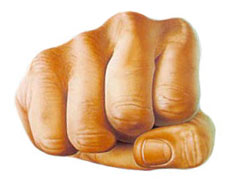
LA Times....
Why are our hands the shape that they are? Compared with those of other apes, the thumb is longer and the palms and fingers are short. Scientist have a variety of ideas as to why they evolved to be that way:
--The comparatively longer thumb allows us so much more dexterity, permitting us to make tools.
--The proportions of the hand may be the indirect consequence of natural selection for a foot with a long toe, so handy for keeping balance while walking. (Hand and foot development occur along very similar lines, and many of the same molecules are involved. That means natural selection for one would affect development of the other as well.)
Researchers at the University of Utah have another suggestion: The hand is the shape that it is because it allows us to make a nice fist for fighting that protects key parts of the hand from harm.
The proposal, made by student Michael Morgan and biologist David Carrier, was published in the Journal of Experimental Biology. The duo tested their hypothesis in a series of experiments in which men pounded punching bags, squeezed pressure sensors or performed one-handed push-ups on top of pressure sensors. From this, the scientists learned that force meted out by the hand is about the same when a bag is punched by a fist versus slapped, but nearly twice as great when you consider that the fist delivers its force to a smaller surface area. The study also found that the knuckle joint of the index finger is rendered stiffer and more stable -- transfering force more effectively and protecting the hand -- when a tight fist is made.
In other words, the fist is a dandy fighting tool.
Here’s a summary of the article at the journal site and the scholarly paper itself.
The duo isn’t saying that the advantages of manual dexterity and selection for a different foot shape played no part in hand evolution -- just that fighting may have done so as well.
And, they write, “there appears to be a paradox in the evolution of the human hand. It is arguably our most important anatomical weapon, used to threaten, beat and sometimes kill to resolve a conflict. Yet it is also the part of our musculoskeletal system that crafts and uses delicate tools, plays musical instruments, produces art, conveys complex intentions and emotions, and nurtures.â€
You could imagine a lot of hand shapes that could do one of those two skill sets well, they write. “There may, however, be only one set of skeletal proportions that allows the hand to function both as a mechanism for precise manipulation and as a club for striking.â€
--The comparatively longer thumb allows us so much more dexterity, permitting us to make tools.
--The proportions of the hand may be the indirect consequence of natural selection for a foot with a long toe, so handy for keeping balance while walking. (Hand and foot development occur along very similar lines, and many of the same molecules are involved. That means natural selection for one would affect development of the other as well.)
Researchers at the University of Utah have another suggestion: The hand is the shape that it is because it allows us to make a nice fist for fighting that protects key parts of the hand from harm.
The proposal, made by student Michael Morgan and biologist David Carrier, was published in the Journal of Experimental Biology. The duo tested their hypothesis in a series of experiments in which men pounded punching bags, squeezed pressure sensors or performed one-handed push-ups on top of pressure sensors. From this, the scientists learned that force meted out by the hand is about the same when a bag is punched by a fist versus slapped, but nearly twice as great when you consider that the fist delivers its force to a smaller surface area. The study also found that the knuckle joint of the index finger is rendered stiffer and more stable -- transfering force more effectively and protecting the hand -- when a tight fist is made.
In other words, the fist is a dandy fighting tool.
Here’s a summary of the article at the journal site and the scholarly paper itself.
The duo isn’t saying that the advantages of manual dexterity and selection for a different foot shape played no part in hand evolution -- just that fighting may have done so as well.
And, they write, “there appears to be a paradox in the evolution of the human hand. It is arguably our most important anatomical weapon, used to threaten, beat and sometimes kill to resolve a conflict. Yet it is also the part of our musculoskeletal system that crafts and uses delicate tools, plays musical instruments, produces art, conveys complex intentions and emotions, and nurtures.â€
You could imagine a lot of hand shapes that could do one of those two skill sets well, they write. “There may, however, be only one set of skeletal proportions that allows the hand to function both as a mechanism for precise manipulation and as a club for striking.â€


Comment